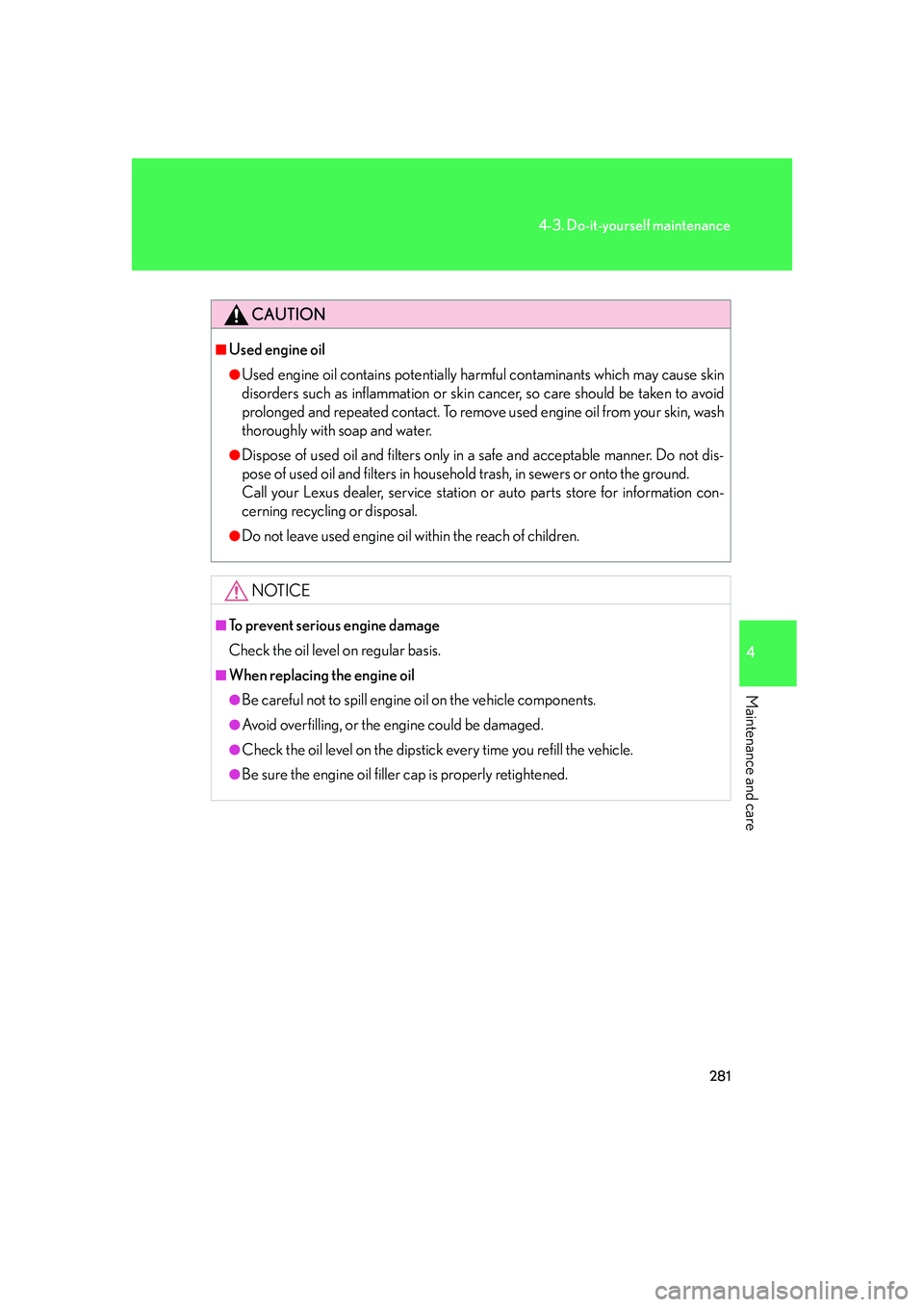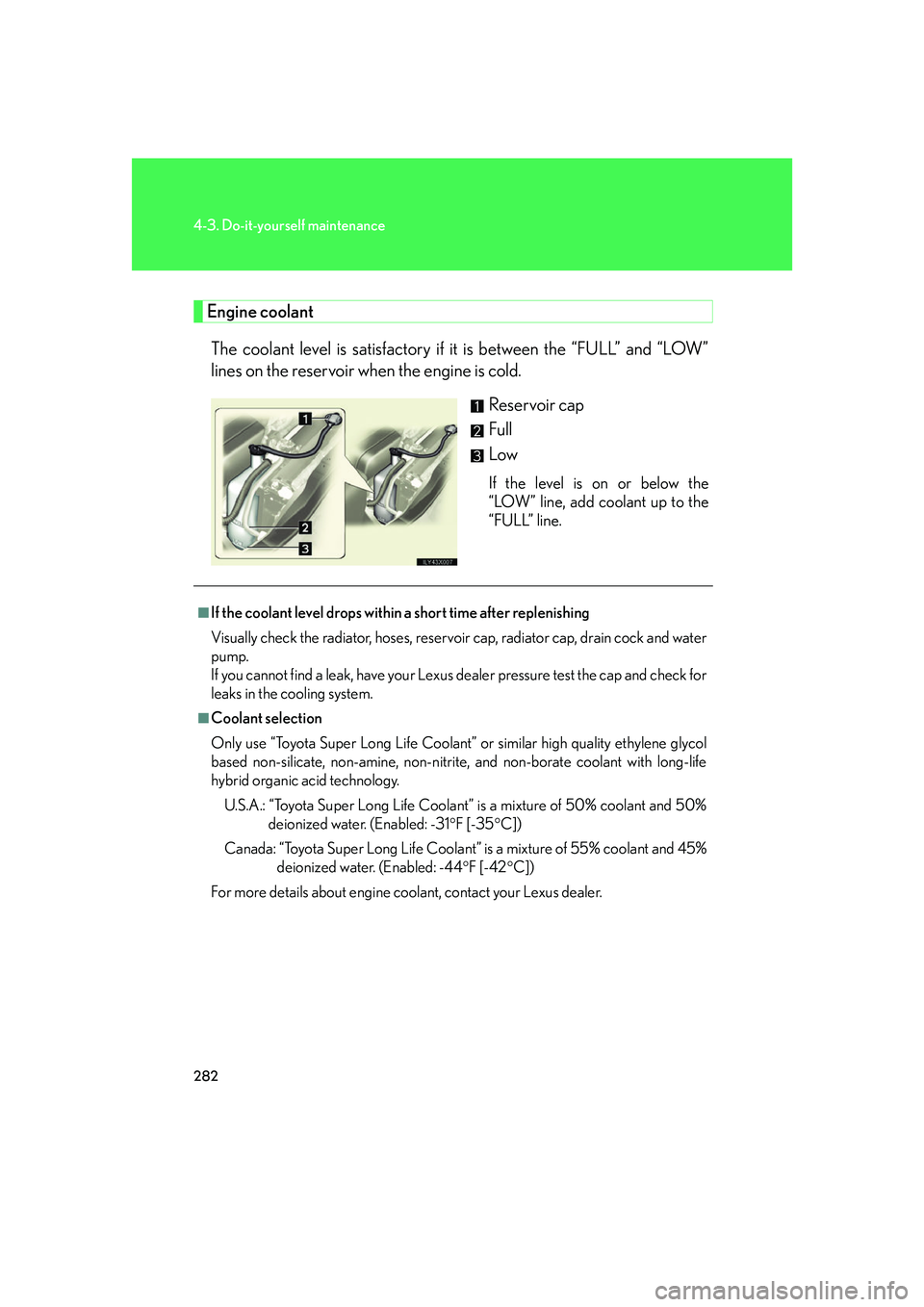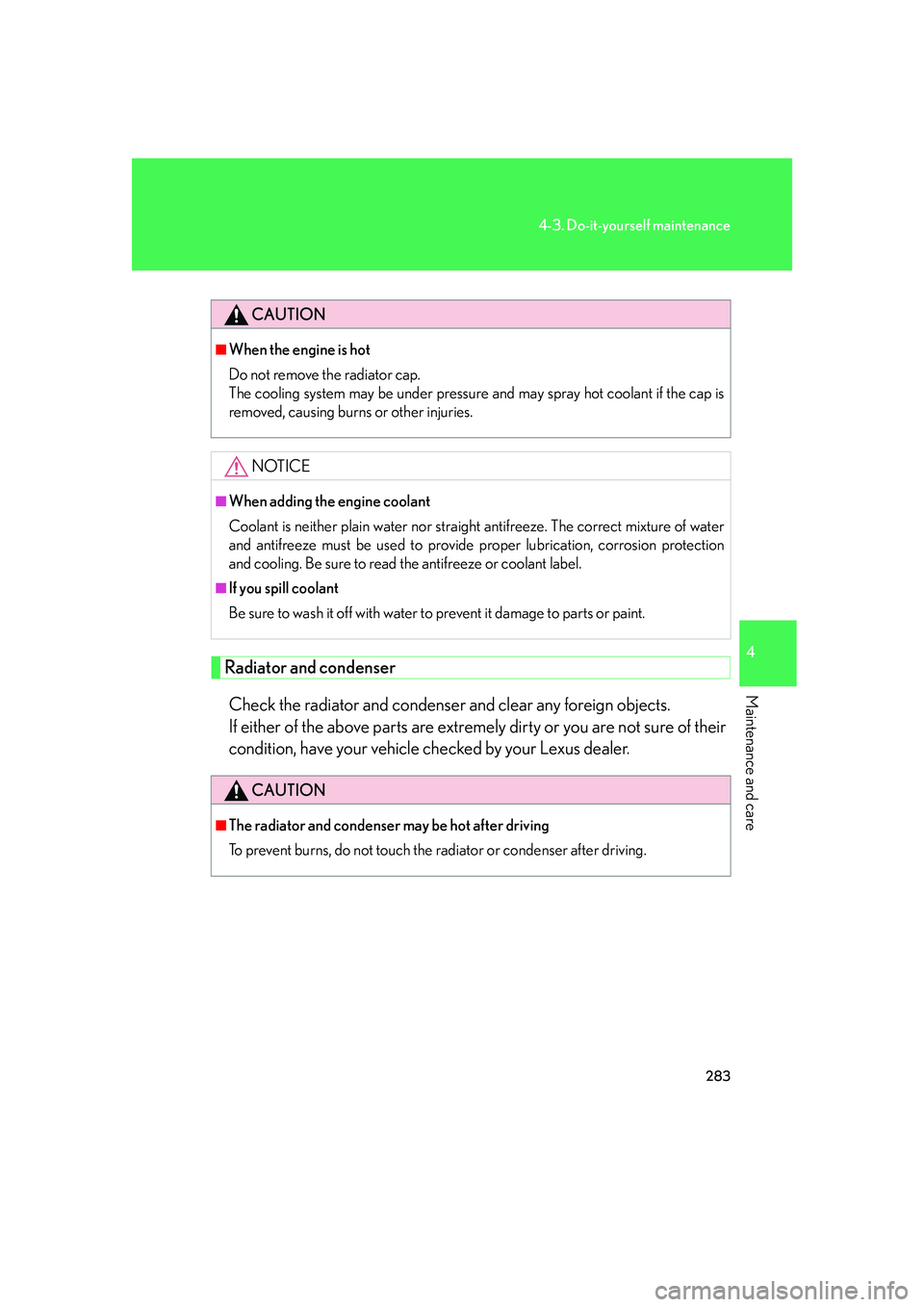engine LEXUS LX470 2007 Workshop Manual
[x] Cancel search | Manufacturer: LEXUS, Model Year: 2007, Model line: LX470, Model: LEXUS LX470 2007Pages: 426, PDF Size: 10.95 MB
Page 298 of 426

280
4-3. Do-it-yourself maintenance
■Engine oil consumption
●The amount of engine oil consumed depends on the oil viscosity, the quality of
the oil and the way the vehicle is driven.
●More oil is consumed under driving conditions such as high speeds and fre-
quent acceleration and deceleration.
●A new engine consumes more oil.
●When judging the amount of oil consumpt ion, keep in mind that the oil may
have become diluted, making it difficult to judge the true level accurately.
●Oil consumption: Max. 1.1 qt./600 miles, 0.9 lmp.qt./600 miles (1.0 L per 1000
km). If the vehicle consumes more than this amount, contact your Lexus dealer.
■Resetting the engine oil main tenance data (U.S.A. only)
Perform the following steps:
Turn the ignition key to the “LOCK” position with the odometer reading
shown.
Turn the ignition key to the “ON” position with the “ODO/TRIP” knob
held down.
Keep pressing the knob for longer th an 7 seconds after the ignition key is
in “ON” position.
After the above operation, the engine oil replacement reminder light goes off.
If the system fails to reset, the light wi ll remain flashing. In this case, return to
and try again.
STEP1
STEP2
STEP3
STEP1
Page 299 of 426

281
4-3. Do-it-yourself maintenance
4
Maintenance and care
CAUTION
■Used engine oil
●Used engine oil contains potentially harmful contaminants which may cause skin
disorders such as inflammation or skin cancer, so care should be taken to avoid
prolonged and repeated contact. To remove used engine oil from your skin, wash
thoroughly with soap and water.
●Dispose of used oil and filters only in a safe and acceptable manner. Do not dis-
pose of used oil and filters in househol d trash, in sewers or onto the ground.
Call your Lexus dealer, service station or auto parts store for information con-
cerning recycling or disposal.
●Do not leave used engine oil within the reach of children.
NOTICE
■To prevent serious engine damage
Check the oil level on regular basis.
■When replacing the engine oil
●Be careful not to spill engine oil on the vehicle components.
●Avoid overfilling, or the engine could be damaged.
●Check the oil level on the dipstick every time you refill the vehicle.
●Be sure the engine oil filler cap is properly retightened.
Page 300 of 426

282
4-3. Do-it-yourself maintenance
Engine coolantThe coolant level is satisfactory if it is between the “FULL” and “LOW”
lines on the reservoir when the engine is cold.
Reservoir cap
Full
Low
If the level is on or below the
“LOW” line, add coolant up to the
“FULL” line.
■If the coolant level drops within a short time after replenishing
Visually check the radiator, hoses, reservoir cap, radiator cap, drain cock and water
pump.
If you cannot find a leak, have your Lexus dealer pressure test the cap and check for
leaks in the cooling system.
■Coolant selection
Only use “Toyota Super Long Life Coolant” or similar high quality ethylene glycol
based non-silicate, non-amine, non-nitrite, and non-borate coolant with long-life
hybrid organic acid technology.
U.S.A.: “Toyota Super Long Life Coolant” is a mixture of 50% coolant and 50%
deionized water. (Enabled: -31F [-35 C])
Canada: “Toyota Super Long Life Coolant” is a mixture of 55% coolant and 45% deionized water. (Enabled: -44 F [-42C])
For more details about engine coolant, contact your Lexus dealer.
Page 301 of 426

283
4-3. Do-it-yourself maintenance
4
Maintenance and care
Radiator and condenserCheck the radiator and condenser and clear any foreign objects.
If either of the above parts are extremely dirty or you are not sure of their
condition, have your vehicle checked by your Lexus dealer.
CAUTION
■When the engine is hot
Do not remove the radiator cap.
The cooling system may be under pressure and may spray hot coolant if the cap is
removed, causing burns or other injuries.
NOTICE
■When adding the engine coolant
Coolant is neither plain water nor straight antifreeze. The correct mixture of water
and antifreeze must be used to provide proper lubrication, corrosion protection
and cooling. Be sure to read the antifreeze or coolant label.
■If you spill coolant
Be sure to wash it off with water to prevent it damage to parts or paint.
CAUTION
■The radiator and condenser may be hot after driving
To prevent burns, do not touch the radiator or condenser after driving.
Page 304 of 426

286
4-3. Do-it-yourself maintenance
Power steering fluid■ Fluid level
The fluid level should be within the appropriate range.
Full (when hot)
Add fluid (when hot)
Full (when cold)
Add fluid (when cold)
Hot: Vehicle has been driven arou nd 50 mph (80 km/h) for 20 min-
utes, or slightly longer in frig id temperatures. (Fluid tempera-
ture, 140°F - 175°F [60°C - 80°C]).
Cold: Engine has not been run for about five hours. (Room tempera- ture, 50°F - 85°F [10°C - 30°C]).
■ Checking the fluid level
Make sure to check the fluid type and prepare the necessary items.
Clean all dirt off the reservoir.
Remove the cap by turning it counterclockwise.
Wipe the dipstick clean.
Reinstall and remove the reservoir cap again.
Check the fluid level.
Fluid typeAutomatic transmission fluid DEXRON® II or III
ItemsRag or paper, Clean funnel (only for adding fluid)
STEP1
STEP2
STEP3
STEP4
STEP5
Page 306 of 426

288
4-3. Do-it-yourself maintenance
■Checking the fluid level
Check the fluid level under the unloaded condition.
Start the engine and put the vehicle height in the “LO” (Low)
mode and then “N” (Normal) mode.
Turn off the ignition switch about 30 seconds after the “N” (Nor-
mal) mode indicator light comes on.
Make sure the fluid level is between “MAX” and “MIN”.
If the fluid level is lower than “MIN ”, have suspension fluid AHC filled by
your Lexus dealer.
Battery
■ Exterior
Make sure that the battery terminals ar e not corroded and that there are
no loose connections, cracks, or loose clamps.
Terminals
Hold-down clamp
STEP1
STEP2
STEP3
Page 309 of 426

291
4-3. Do-it-yourself maintenance
4
Maintenance and care
Washer fluidIf any washer does not work or the
low washer fluid warning light
come on the washer tank may be
empty. Add washer fluid.
NOTICE
■When recharging the battery
Never recharge the battery while the engine is running. Also, be sure all accesso-
ries are turned off.
NOTICE
■Do not use any fluid other than washer fluid
Do not use soapy water or engine antifreeze instead of washer fluid.
Doing so may cause streaking on the vehicle’s painted surfaces.
■Diluting washer fluid
Dilute washer fluid with water as necessary.
Refer to the freezing temperatures listed on the washer fluid tank.
Page 329 of 426

311
4-3. Do-it-yourself maintenance
4
Maintenance and care
Checking and replacing fuses
If any of the electrical components do not operate, a fuse may have blown.
If this happens, check and replace the fuses as necessary.
Turn the ignition key to the “LOCK” position.
Open the fuse box cover.
Engine compartment
Push the tab in and lift the lid off.
Push the tab in and lift the lid off.STEP1
STEP2
Page 332 of 426

314
4-3. Do-it-yourself maintenance
Fuse layout and amperage ratings■ Engine compartment
FuseAmpereCircuit
1ABS NO.240Anti-lock brake system
2ABS NO.150Anti-lock brake system
3AHC50Active height control suspension
(AHC)
4WIP-S7. 5No circuit
5TOW I N G30Trailer lights
6MIR HTR15Outside rear view mirror defogger
7RR HTR10Rear air conditioning system
8HAZ-TRN15Emergency flashers, Turn signal lights
Page 345 of 426

When trouble arises5
327
5-1. Essential information............ 328If your vehicle needs to be towed .......................................... 328
If you think something is wrong .......................................... 333
Fuel pump shut off system ..... 334
Event data recorder ................. 335
5-2. Steps to take in an emergency............................ 337
If a warning light turns on or a warning buzzer sounds...
......... 337
If you have a flat tire.................. 346
If the engine will not start ....... 357
If the shift lever cannot be shifted from P........................... 358
If you lose your keys ................. 359
If the battery is discharged .... 360
If your vehicle overheats ........ 363
If the vehicle becomes stuck ............................................ 366